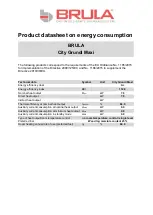
5
Operating instructions
Operation of the basic stove
The fireplace should only be operated by adults, supervise children! Only use
suitable lighting and burning materials as described in these operating instructions.
Check whether there is a good combustion air supply to ensure perfect operation of
the fireplace.
Initial commissioning
All the documents, accessories, tools and other objects provided must be removed
from the firebox. Inform yourself fully as regards fuels (refer to page 8). To avoid
cracks and damage when using for the first time, all cladding elements and
components must be dry. The first burnup should be at a reduced heat, i.e., not with
the full amount of fuel as the stove must firstly get used to the development of heat.
Any smells which occur (e.g., from the firebox door) dissipate after a short time.
Heating up
Approx. 1.5 kg of small dry pieces of beech wood (2 to 4 cm in diameter with a max.
length of 33 cm) and a handful of chippings are ideal for heating up. Since the
combustion air flows from above into the combustion chamber, it should be ensured
that the wood is stacked loosely in the combustion chamber. The chippings are
placed in the middle of the pile.
This allows the combustion air to flow freely through the firewood.
The air controller is opened fully for heating up and each time more fuel is added.
To do this, turn the controller anti-clockwise. Stick lighters, long matches or other
suitable lighters are ideal for lighting the fire in the combustion chamber. The
chippings in the middle of the wood pile aid ignition.
Alternatively, firelighters made of wood wool soaked in wax or similar can be used.
If the relationship between the basic stove and chimney is OK, the door can be
closed straight away.
Note: The residual moisture from the firewood will initially settle on the glass pane.
Heating up takes longer than 2 minutes and requires a little patience. To optimise the
draught in the chimney, the firebox/draughts and chimney must firstly reach their
operating temperature. As combustion progresses, the moisture which initially
collected on the glass pane evaporates.



































